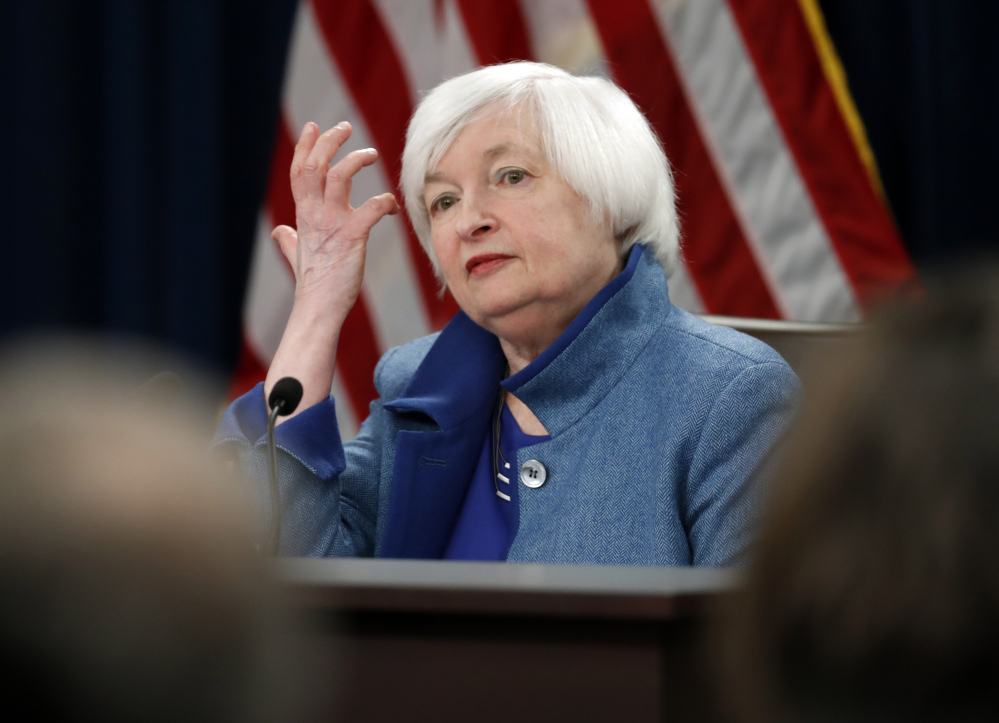WASHINGTON – The Federal Reserve has raised a key interest rate in response to a strengthening U.S. economy and expectations of higher inflation, and it foresees three more rate hikes in 2017.
The Fed’s move will mean modestly higher rates on some loans.
Wednesday’s action signaled the Fed’s belief that the U.S. economy has improved over the past year after a rough start to 2016 and can withstand slightly higher borrowing rates. Its expectation of three rate increases in 2017 is up from two from its forecast three months ago.
The central bank said in a statement after its latest policy meeting that it’s raising its benchmark rate by a quarter-point to a still-low range of 0.5 percent to 0.75 percent. The Fed last raised the rate last December from a record low near zero set during the 2008 financial crisis.
The Fed’s move, only the second rate hike in the past decade, came on a unanimous 10-0 vote. It also released an updated economic forecast that showed modest changes to its outlook for economic growth, unemployment and inflation, mainly to take account of a stronger economy and a drop in the unemployment rate for November to a nine-year low of 4.6 percent.
James Marple, senior economist at TDBank, said the Fed’s forecast of three rate increases next year, up from two, was the “only real surprise” Wednesday.
“The move up is a signal that the Fed has become more confident in the economic outlook and that inflation will increasingly track closer to the 2 percent target,” Marple said.
LITTLE EFFECT EXPECTED ON MORTGAGES
The Fed’s rate hike should have little effect on mortgages or auto and student loans. The central bank doesn’t directly affect those rates, at least not in the short run. But rates on some other loans – notably credit cards, home equity loans and adjustable-rate mortgages – will likely rise soon, though only modestly. Those rates are based on benchmarks like banks’ prime rate, which moves in tandem with the Fed’s key rate.
“This single quarter-point move in interest rates will go largely unnoticed at the household level, but coupled with last year’s hike, the cumulative effect could mount quickly if the Fed quickens the pace of rate hikes in 2017,” said Greg McBride, Bankrate.com’s chief financial analyst.
After the Fed’s announcement, several major banks announced that they were raising their prime lending rate from 3.50 percent to 3.75 percent. The prime rate is a benchmark for some types of consumer loans such as home equity loans. BB&T and Citigroup were among the banks to announce the increase.
Mortgage rates have been surging since Donald Trump’s presidential victory last month on expectations that his program of deregulation, tax cuts and increased spending on infrastructure would accelerate economic growth and inflation.
At a news conference, Chair Janet Yellen said she didn’t think the economy needed stimulus from Trump’s spending plan – the kind of fiscal support that both Yellen and her Fed predecessor, Ben Bernanke, had called for in the past.
Yellen said such policies would be unlikely to maximize employment, since the unemployment rate is now slightly below the Fed’s own long-term target.
“I believe my predecessor and I called for fiscal stimulus when the unemployment rate was substantially higher than it is now,” she said.
LOWER UNEMPLOYMENT RATE CITED
The Fed chair stressed that she was not providing advice or guidance to the incoming Trump administration. She also downplayed any expectations that Trump’s economic program could lead to faster rate hikes as a result of from higher growth and inflation.
Yellen attributed the Fed’s higher number of estimated rate hikes for 2017 to a lower unemployment rate and possibly some changes in federal budget policy beginning next year. But she emphasized that any changes to the Fed’s projections were “modest.”
“This is a very modest adjustment in the path of the federal funds rate,” she said.
The Fed’s new projections have the unemployment rate dipping to 4.5 percent by the end of 2017 and remaining at that level in 2018. It foresees economic growth reaching 1.9 percent this year and 2.1 percent in 2017. That’s slightly more optimistic than the Fed projected in September.
The central bank kept its long-term estimate for economic growth at 1.8 percent, far below the 4 percent pace that Trump has said he can achieve with his economic program.
Overall, the Fed’s policy statement showed modest changes in wording from the previous meeting. It said “economic activity has been expanding at a moderate pace since mid-year” helped along by solid job growth. And it noted that inflation expectations “have moved up considerably but still are low.”
Trump’s plans for tax cuts and infrastructure spending have led investors to expect that inflation will pick up in coming months.
The economy, after growing at an anemic annual rate of 1.1 percent in the first half of this year, accelerated to a 3.2 percent pace in the July-September quarter. That pickup has lifted hopes that the economy will keep rising, fueled by steady hiring gains.
In the month since Trump’s victory, investors have sent stock prices surging to record highs and driven up bond yields. The markets have calculated that Republican control of Congress will enable Trump to cut taxes, ease regulations and accelerate infrastructure spending – and that higher economic growth, inflation and corporate profits will result.
Some Fed watchers expect faster growth to lead the central bank to shift its focus from trying to energize the economy to considering ways to counter the risk of too-high inflation. Others note that Trump’s economic program still must win congressional approval and could undergo significant change along the way.
Send questions/comments to the editors.



Comments are no longer available on this story